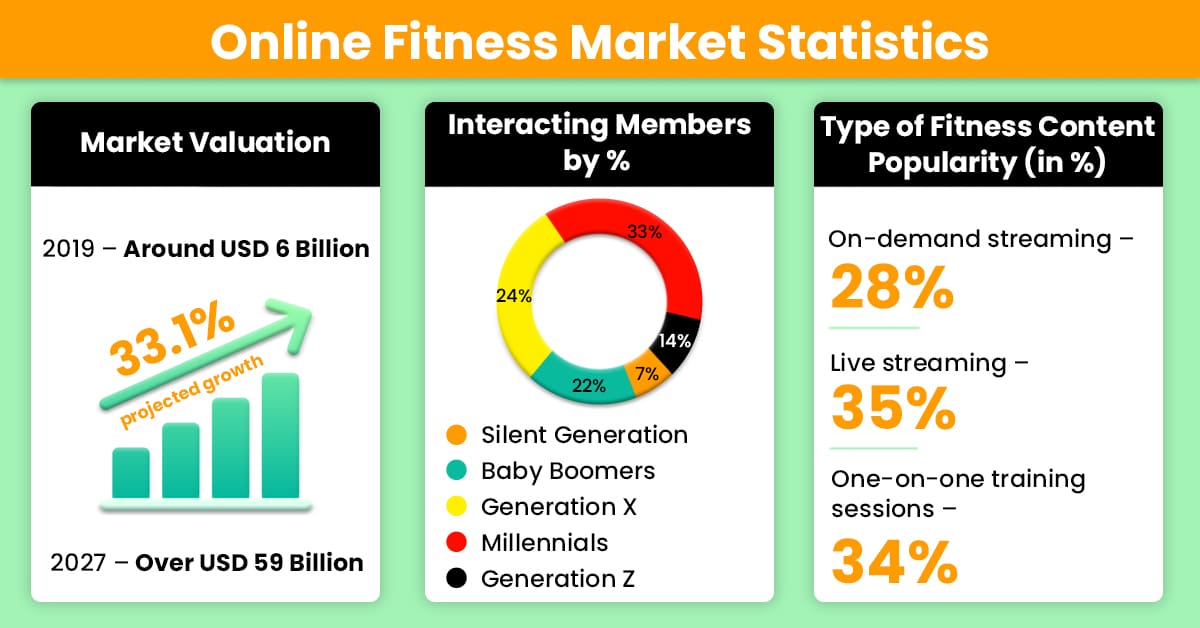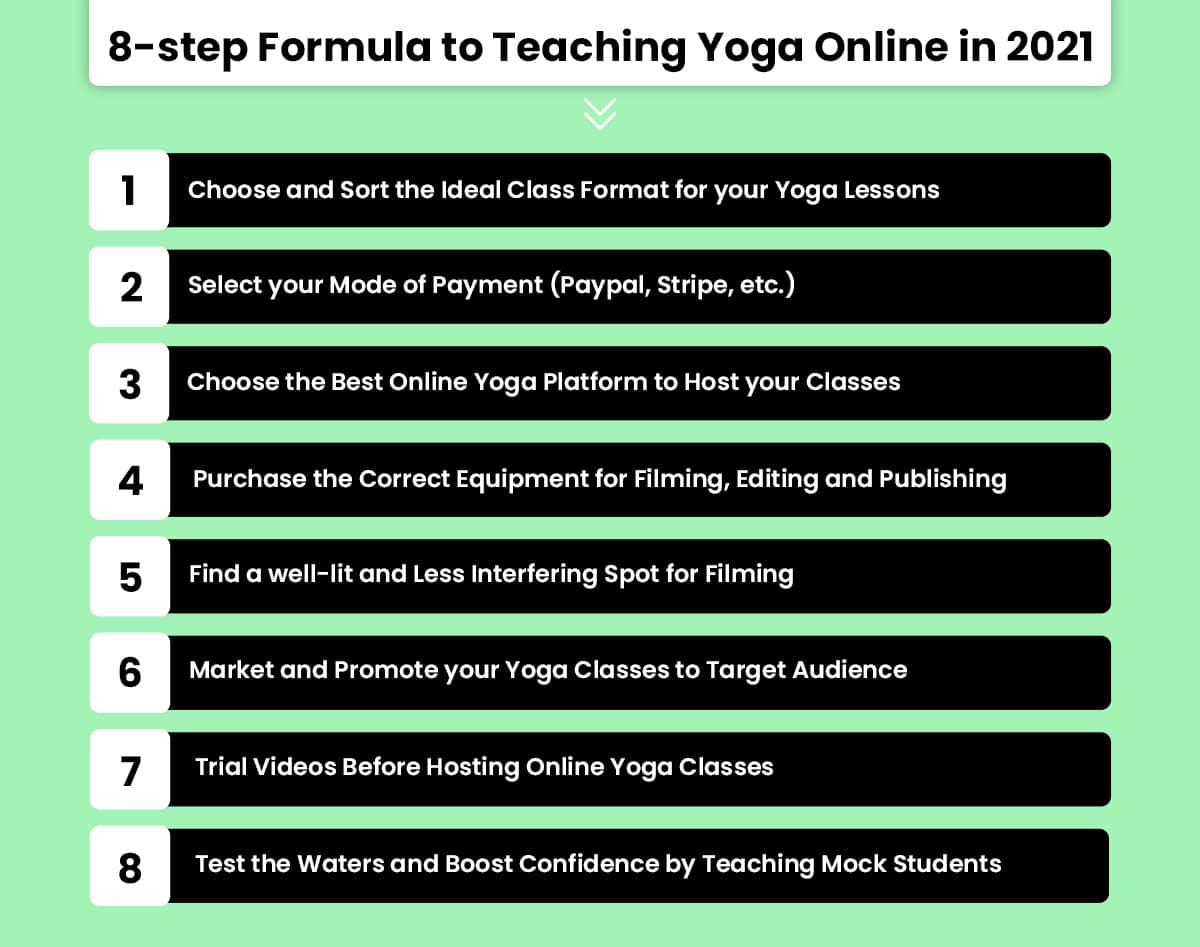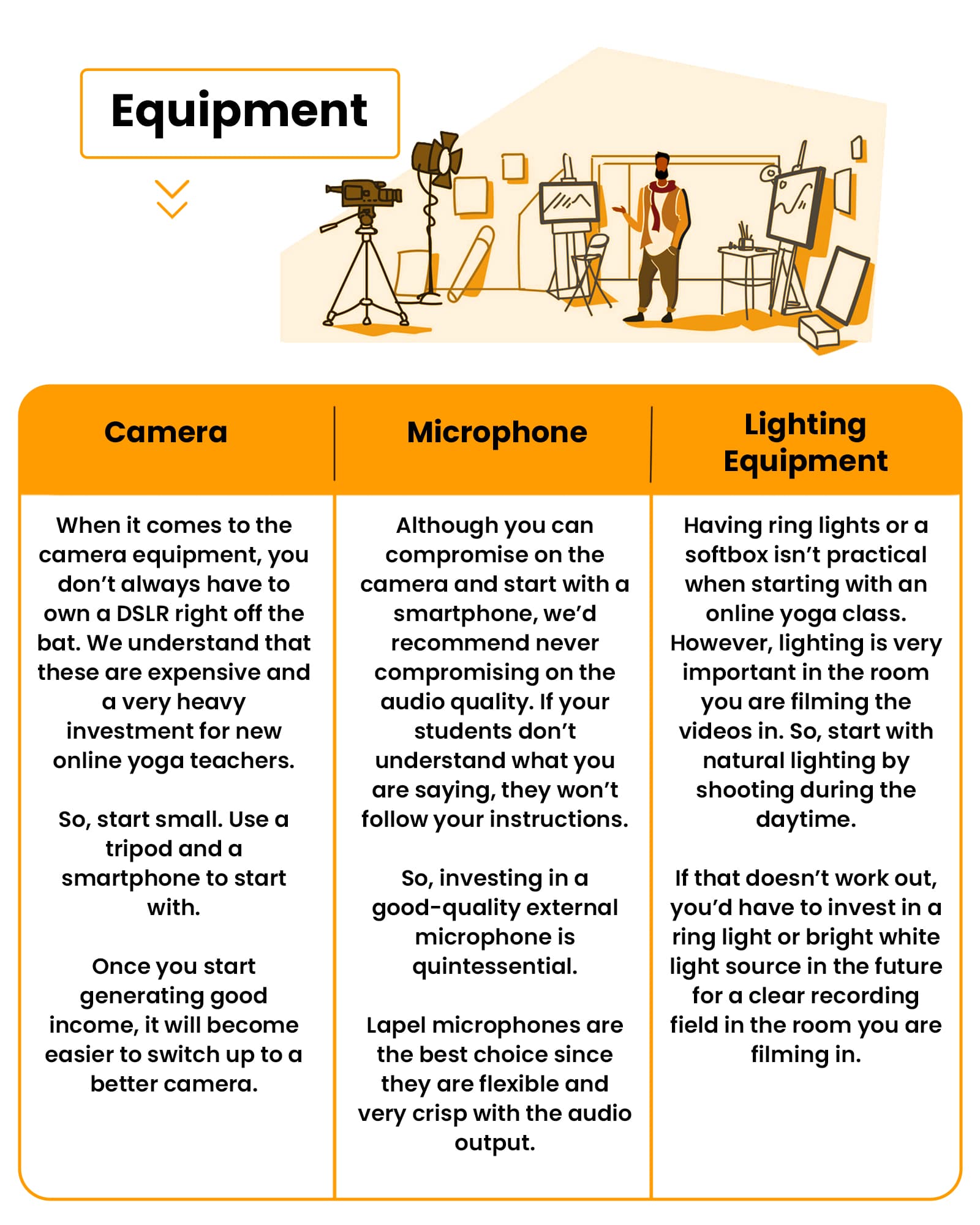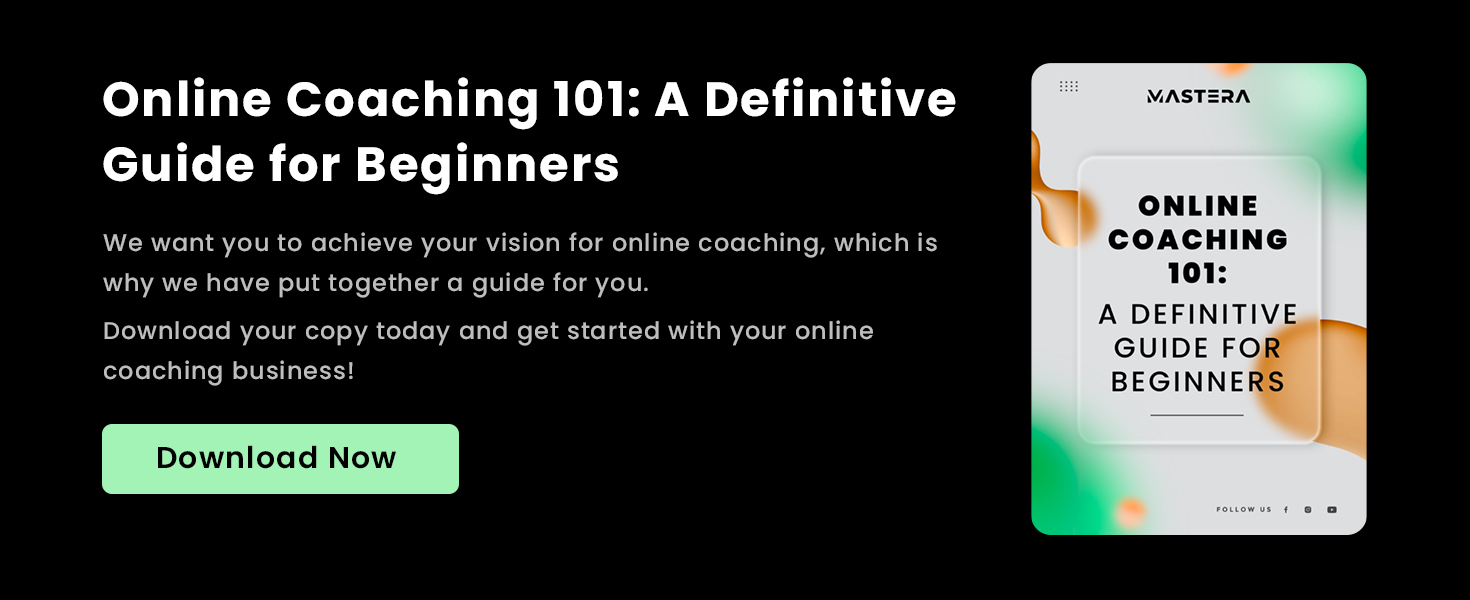According to Allied Market Research Report, the online fitness industry is set to grow by 33.1% by 2027. The market’s valuation is expected to skyrocket to $59,231 million by the end of 2027. And Online Yoga Teaching is part of the whole growth.
With the world suffering from a pandemic and the sudden halt to “traditional” services like gyms and fitness centers, it isn’t surprising that people have chosen to make a virtual shift. And, online fitness training and yoga have taken the front seat.
If you have professional experience teaching yoga and want to engage in a high-paying side hustle, teaching yoga online is a lucrative option. It is a low-investment hustle where you can leverage an interactive platform like Mastera to share your training, courses, and on-demand videos with your viewers.
However, we understand that starting an online business requires strategy and planning. So, this article will dive deep into understanding the ropes of the best yoga teaching platforms and the strategies involved to make it a high-paying business model.
Step-By-Step Guide to Teaching Yoga Online
When curating a guide to starting teaching yoga online, there are several factors worth noting. Not just the teaching platform, you need to focus on the content you share, the steps involved in connecting with your audience, and how to turn your business idea into a profitable business model.
Although starting to teach online yoga can seem “futile” now, we’d urge you to keep faith in the process. Despite what you think, everyone across the globe is looking for ways to attain their best health. And, while weight training might not be accessible to all, yoga can be done from the comfort of one’s home.
So, it isn’t surprising that trainers are now looking into the best platforms for teaching yoga online. Hang on tight, read through the tips, and make the most out of the situation.
Step 1 – Pick Your Yoga Course and Choose Your Class Format
The tallest building in the world started with a base. The same applies to any and every business model too.
If you don’t have any clarity about your yoga classes, there’s going to be no success in the end. As a virtual instructor, you need to determine two factors-
- The audience or consumers you are targeting.
- What kind of yoga or courses do you want to indulge in?
The moment you have a clear answer to these two questions, it becomes a lot easier for you to plan your courses, the content you want to share, and how you want to market your business.
Determining the target audience can help you curate yoga courses and classes aligned to their interests. Ideally, if you don’t have a plan and try to cater your courses to EVERYONE, it will result in chaos.
With yoga, the process is very subjective. This means you need to proceed with caution and offer courses and classes that target a certain demographic. Some could join your classes because they have muscle stiffness; some could join your classes because they want to stay fit and healthy.
Determining the audience base ensures that your classes benefit them individually and then reap the maximum value out of their investment in the classes.
Besides the content, you also want to decide the format of classes you want to stick to. Some online yoga instructors rely on pre-recorded classes, while some indulge in live zoom sessions.
When selecting the class format (online or pre-recorded), you also want to ascertain how many students you want to teach at a time. Often, we’d recommend starting with smaller groups or individual yoga lessons. These make the classes more interactive, allowing you to establish your repertoire in the market.
If you are a professional with prior experience teaching yoga online, we’d recommend taking up student insights and then building your classes around that.
Step 2 – Decide On How You Want To Get Paid As An Online Yoga Teacher
When you start as an online yoga teacher, your primary goal is to monetize your business model. So, deciding the monetization source is equally important as choosing the best online yoga platform. It doesn’t matter whether you are starting this as a side hustle or a full-time gig; you want to generate enough revenue to sustain your basic business needs.
You want to monetize the knowledge that is up to market standards, feasible for every kind of user or audience, and brings you enough profit to sail through.
Your revenue model for an online yoga business can either be based on:
- Charged per lesson
- Charged per subscription/membership
- Charged per course
Always keep a standard rate for the classes and don’t change them depending on the enquiring students. This enhances the volatility of the business and puts out a bad word about your business too.
Some online yoga instructors also accept year-round donations from their students besides the lesson fees. You can integrate that into your business too. This allows you to understand how appreciative the students are and make you realize whether the students are enjoying the lessons or not.
Besides deciding the amount of the course fees, you also need to sort out a payment gateway choice. If you are using a learning management system like Mastera, you’d have e-Commerce payment gateway plug-ins that you can select from. However, if you are starting small and want easier payment options, PayPal and Stripe are convenient. Mastera allows you to integrate third-party payment gateways for easy transactions.
Also, keep in mind that the online fitness industry is becoming more and more competitive. So, when deciding the prices for the courses or classes, keep your research strong. Compare the prices on other platforms, check what courses or classes other yoga instructors provide, and lastly, strategize the revenue for a PROFITABLE business model.
Step 3 – Choose A Virtual Studio to Stream Yoga Classes Online
There are several online yoga platforms for teachers that you will stumble across on the internet. Starting with open social media platforms like Facebook and YouTube can seem good, but there’s only so much you can earn from such platforms.
If you want to turn the whole idea into a profitable business model, we’d recommend that you choose a private platform, otherwise known as a learning management system (LMS). These offer multiple course-building templates and integrated features that allow you to streamline your online yoga classes.
Since they are subscription-based or encrypted platforms, it isn’t surprising that they require the user to pay the fees to access the available content on the subjective platform.
Using a dedicated online learning platform like Mastera allows you to forget about the accessory features and worries that come with it. When you have the payment and structure of the business taken care of by the platform, all you have to do is ensure that you provide the students with quality content that they feel good paying for.
Mastera is an all-in-one solution for your virtual yoga class business. Not only do you get to have an integrated platform to share your ideas and courses, but the platform also allows you to create schedules, take individual bookings, and have a streamlined payment interface.
Step 4 – Get Your Tools and Equipment Ready
In a world where the competition for online business models is cutthroat, you don’t have any room for mistakes. So, when it comes to starting your journey as an online instructor, you need to focus on the quality of the videos you are sharing.
From the backdrop to the camera equipment you are shooting with, everything needs to be top-notch, so the students feel like their money is going somewhere worthy.
Remember that you aren’t teaching yoga just for the “FUN” factor. However, you are spending the time and effort to generate revenue that can sustain you. So, you need to give back the same kind of investments too.
When you are teaching anything online, there are three factors that you need to consider.
- Video quality
- Audio quality
- Lighting
And, to achieve these three, you need to invest in a good-quality camera, microphone and light screen so you can shoot your videos without any restrictions along the way.
 Step 5 – Set Up Your Filming/ Streaming Location
Step 5 – Set Up Your Filming/ Streaming Location
Yoga is all about being in a zen moment with less clutter and open space to let the body’s flexibility take over.
Even if you are filming inside your home or in your room, you want the space to look spacious, open, and organized. Decorating the backdrop of the video is crucial. If you have everything piled up and lining in your background, it will eventually destroy the whole credibility of the video you are sharing.
So, aim for open spaces in the house. Also, aim for calm spots and won’t experience interruptions with loud traffic noise. Moreover, you want enough space between you and the camera so you don’t end up flinging it across the room while doing a yoga pose.
Besides the space, the filming setup should also have open windows to allow more entry of natural light. Trust us; there’s nothing that beats the quality of natural light. Also, if you have limited space, invest in a wide-angle camera to cover the entirety of the room in the lens.
Especially for online streaming of the yoga lessons, you want to film in a spot that has consistent light and background setup. So, practicing in front of a window is ideal because you have enough lighting to get through. If natural lighting isn’t a possibility, invest in a ring light.
Step 6 – Market and Promote Your Online Yoga Classes
There is no purpose to a business without marketing. If you don’t promote your services or yoga classes to the target audience, no one will know about them in the first place.
There are several ways you can get started when it comes to marketing. You can either leverage the marketing tools available on the online yoga studio platform, or you can take things up a notch.
Email marketing is a tried, tested, and proven marketing tactic that works. You want your marketing agenda to showcase what you offer and give enough reason for the potential audience to sign up and join in. If the audience fails to see the passion behind the project, they will likely move ahead to the next best choice.
You want to emphasize the importance of yoga, how it can help people’s lives and why they need to enroll in your program. Keep the pricing and features aside, convince your audience that your yoga classes are what they are missing in their lives.
Go that extra mile to leverage the power of social media and promote your yoga classes there too. With the right planning and execution, you can seamlessly market the classes and even get interested candidates enrolled in no time at all.
Step 7 – Make Sure Everything Works
Test videos and test shots are a lifesaver. If you are doing pre-recorded lessons that you will publish for the audience or members to access, you want to make a test run. This isn’t even a question at this point.
Check the quality of the video, the audio output, and the camera placement with the backdrop and the setup.
You need to indulge in this to ensure that your audience is getting the best quality there is. From the clarity in the video and audio recording to focusing on the backdrop, you need a 1-2 mins test run video to ascertain everything is in the right place.
Doing a few trials in different parts of the filming room also allows you to find the best location, angles, and setup that works the best. You always can’t whip up something last minute and hope to God it works. This will eventually affect the quality of the overall scene.
Step 8 – Teach Some Mock Students and Record Everything
For the online yoga teachers who are just starting, gaining experience is quintessential. And, there’s no better way of doing this than indulging in some trial classes. It can be a few beta classes for interested candidates, or you can make a group of friends join your classes for a day or two.
Ensure that you are recording the lessons while you are doing them. This reflects the overall experience and allows you to check the areas you need to work on.
As said, “Practice makes a man perfect.” So, if you are stressed in the first few rounds, worried that you aren’t doing things perfectly and with confidence, be assured that this will change once you practice more. It is a work in progress, so it isn’t surprising that you will make mistakes in the beginning.
However, having recorded lessons allow you to familiarize yourself with those mistakes and work on them. Improving the small things will eventually make things work out perfectly for you.
Why Mastera Is the Best Platform for Teaching Yoga Online

Mastera stands out as the biggest contender on the list of platforms. The platform is created with the creator’s interest in mind, so it isn’t surprising why more and more people are leveraging it to kickstart their online business. If you are on the hunt for a viable platform with 0% transaction fees for your online yoga classes, here’s why Mastera is the best option.
Host Live and On-demand Classes
Let us start with the available formats of online classes. Mastera is known for its versatility in supporting different formats of classes and courses. So, not only can you create and publish-on-demand video lessons, but there is also an option to conduct live sessions too. Mastera integrates third-party applications like Zoom to allow smoother online live streaming.
Offers Recurring Revenue Generation
With the available membership and subscription models with Mastera, you get to create recurring revenue on your terms. Mastera gives you 100% ownership of your content and its revenue. So, you can assign your membership plans according to the audience viewership.
Sell More than Videos
Once your online yoga classes take off and you have generated a good following, it becomes easier for you to sell more. Mastera allows you to have multiple income streams besides the primary one, from merchandise to additional premium content.
Open Communication Streams
Don’t you hate it when there’s no system in which you can’t communicate with your audience? Mastera supports open channel communication with your audience. You can get answers to the rightful questions that your audience is on the lookout for. You get to be there for them, resolve their queries and even get feedback.
Calendar Bookings
One unique feature about Mastera that stands out is their 1-1 class bookings and calendar bookings. This allows you to keep up with your schedule and prevent the risks of missing out on important dates and bookings that you have in a day.
Customer Engagement Tools
We call Mastera a one-stop solution for every virtual creator because of the wide range of engagement tools they provide their clients with. The platform integrates a host of intelligent automation, including email marketing, which keeps your business outreach maximum.
No Booking Fee
Everything you earn on Mastera, every single penny is yours to keep. The platform doesn’t charge any extra money or transaction fees for hosting your content. Besides the monthly subscription packages, there’s no extra money you must worry about. So, if you want to own what rightfully is yours, Mastera is your one-stop destination for the same.
Conclusion
The growth of the online fitness industry is currently booming and is not going to see a downfall anytime soon. So, if you plan to mark your presence in the market, there’s no better time than now.
With more and more audiences reverting to online platforms for reaching their fitness goals, it won’t take you long to create your place in the market as an online yoga teacher. All you have to do is keep up with what’s going on and make the most out of the situations in question.
If you are on the hunt for the best online yoga class platform, Mastera is your one-stop destination. With pricing starting as low as $39/month and with a 14-days free trial, you get to make the most out of the situation. So, don’t ponder the thought anymore and act on it immediately before it’s too late to take any action.




 Step 5 – Set Up Your Filming/ Streaming Location
Step 5 – Set Up Your Filming/ Streaming Location
